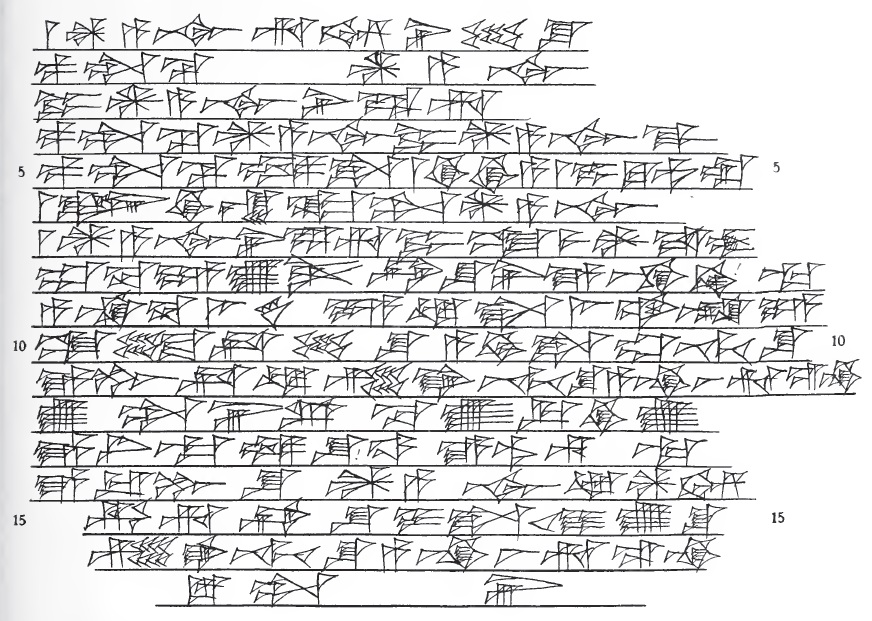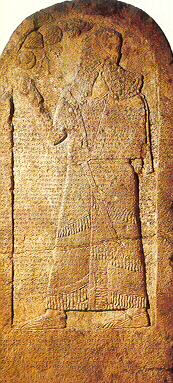|
Ashur-rim-nisheshu
Aššur-rā’im-nišēšu, inscribed md''aš-šur-''ÁG-UN.MEŠ''-šu'', meaning “(the god) Ashur (god), Aššur loves his people,” was ruler of Assyria, or ''išši’ak Aššur'', “vice-regent of Aššur,” written in Sumerian language, Sumerian: PA.TE.SI (=ÉNSI), c. 1408–1401 BC or c. 1398–1391 BC (short chronology), the 70th to be listed on the Assyrian King List. He is best known for his reconstruction of the inner city wall of Assur, Aššur. Biography All three extant ''Assyrian Kinglists''''Khorsabad Kinglist'' iii 7.''SDAS Kinglist'' iii 1.''Nassouhi Kinglist'' iii 11. give his filiation as “son of Ashur-bel-nisheshu, Aššur-bēl-nišēšu," the monarch who immediately preceded him, but this is contradicted by the sole extant contemporary inscription, a clay nail, cone giving a dedicatory inscription for the reconstruction of the wall of the inner city of Aššur, which gives his father as Ashur-nirari II, Aššur-nērārī II (written phonetically on the th ... [...More Info...] [...Related Items...] OR: [Wikipedia] [Google] [Baidu] |
Ashur-bel-nisheshu
Aššūr-bēl-nīšēšu, inscribed md''aš-šur-''EN-UN.MEŠ-''-šú'',''Nassouhi King List'', Istanbul A. 116 (Assur 8836), iii 11–12.''Khorsabad King List'', IM 60017 (excavation nos.: DS 828, DS 32-54), iii 5–6.''SDAS King List'', tablet IM 60484, ii 38. and meaning “(the god) Aššur (is) lord of his people,” was the ruler of Assyria 1417–1409 BC or 1407–1398 BC (short chronology), the variants due to uncertainties in the later chronology. He succeeded his father, Aššur-nērārī II, to the throne and is best known for his treaty with Kassite king Karaindaš. Biography As was the practice during this period of the Assyrian monarchy, he modestly titled himself “vice-regent”, or ''išši'ak Aššur'', of the god Ashur. §236—240. The ''Synchronistic Chronicle''''Synchronistic Chronicle'' (ABC 21), tablet K4401a, i 1–4. records his apparently amicable territorial treaty with Karaindaš, king of Babylon, and recounts that they “took an oath together c ... [...More Info...] [...Related Items...] OR: [Wikipedia] [Google] [Baidu] |
Ashur-nadin-ahhe II
Ashur-nadin-ahhe II ''(Aššur-nādin-ahhē II)'' was king of Assyria from 1400 to 1391 BC. Preceded by Ashur-rim-nisheshu, he was succeeded by his brother, Eriba-Adad I. Ashur-nadin-ahhe is an Assyrian personal name meaning “the god Ashur has given a brother” in the Akkadian language. Two Assyrian kings ruling in the 15th or early 14th century BC were called Ashur-nadin-ahhe. Hardly anything is known about these kings, but one of them is mentioned in one of the Amarna letters. In the letter from king Ashur-uballit of Assyria to the Pharaoh of Egypt, numbered EA 16, Ashur-nadin-ahhe is referred to as his ancestor who wrote to Egypt and received gold in return. This would imply an earlier diplomatic marriage and alliance between Assyria and Egypt during his reign. The name Ashur-nadin-ahhe mentioned in EA 16 has recently been contested as a faulty writing of Ashur-nadin-apli, another Assyrian king. See also *Kings of Assyria The king of Assyria (Akkadian: ''Išši'ak Ašš ... [...More Info...] [...Related Items...] OR: [Wikipedia] [Google] [Baidu] |
List Of Assyrian Kings
The king of Assyria (Akkadian: ''Išši'ak Aššur'', later ''šar māt Aššur'') was the ruler of the ancient Mesopotamian kingdom of Assyria, which was founded in the late 21st century BC and fell in the late 7th century BC. For much of its early history, Assyria was little more than a city-state, centered on the city Assur, but from the 14th century BC onwards, Assyria rose under a series of warrior kings to become one of the major political powers of the Ancient Near East, and in its last few centuries it dominated the region as the largest empire the world had seen thus far. Ancient Assyrian history is typically divided into the Old, Middle and Neo-Assyrian periods, all marked by ages of ascendancy and decline. The ancient Assyrians did not believe that their king was divine himself, but saw their ruler as the vicar of their principal deity, Ashur, and as his chief representative on Earth. In their worldview, Assyria represented a place of order while lands not governed by ... [...More Info...] [...Related Items...] OR: [Wikipedia] [Google] [Baidu] |
King Of Assyria
The king of Assyria (Akkadian: ''Išši'ak Aššur'', later ''šar māt Aššur'') was the ruler of the ancient Mesopotamian kingdom of Assyria, which was founded in the late 21st century BC and fell in the late 7th century BC. For much of its early history, Assyria was little more than a city-state, centered on the city Assur, but from the 14th century BC onwards, Assyria rose under a series of warrior kings to become one of the major political powers of the Ancient Near East, and in its last few centuries it dominated the region as the largest empire the world had seen thus far. Ancient Assyrian history is typically divided into the Old, Middle and Neo-Assyrian periods, all marked by ages of ascendancy and decline. The ancient Assyrians did not believe that their king was divine himself, but saw their ruler as the vicar of their principal deity, Ashur, and as his chief representative on Earth. In their worldview, Assyria represented a place of order while lands not governed by ... [...More Info...] [...Related Items...] OR: [Wikipedia] [Google] [Baidu] |
Assyrian King List
The king of Assyria (Akkadian: ''Išši'ak Aššur'', later ''šar māt Aššur'') was the ruler of the ancient Mesopotamian kingdom of Assyria, which was founded in the late 21st century BC and fell in the late 7th century BC. For much of its early history, Assyria was little more than a city-state, centered on the city Assur, but from the 14th century BC onwards, Assyria rose under a series of warrior kings to become one of the major political powers of the Ancient Near East, and in its last few centuries it dominated the region as the largest empire the world had seen thus far. Ancient Assyrian history is typically divided into the Old, Middle and Neo-Assyrian periods, all marked by ages of ascendancy and decline. The ancient Assyrians did not believe that their king was divine himself, but saw their ruler as the vicar of their principal deity, Ashur, and as his chief representative on Earth. In their worldview, Assyria represented a place of order while lands not governed by ... [...More Info...] [...Related Items...] OR: [Wikipedia] [Google] [Baidu] |
Kikkia
Kikkia (sometimes given as Kikkiya), inscribed m''Ki-ik-ki-a''''Khorsabad Kinglist'', i 23.''SDAS Kinglist'', i 22. was according to the ''Assyrian King List'' (AKL) the 28th Assyrian monarch, ruling in Assyria's early period. He is listed within a section of the AKL as the second out of the six, "kings whose eponyms are not known." As all the other early rulers listed in the king list and unattested elsewhere, there is dispute among scholars as to whether Kikkia was a real historical figure. Apart from his appearance in two copies of the Assyrian King List (the Khorsabad and SDAS copies, but not the Nassouhi one which is damaged at the top where he might have appeared), he is only known from two building inscriptions of his successors, moreover; the earliest of these is that of Ashur-rim-nisheshu (c. 1398 BC — c. 1391 BC), who commemorated his reconstruction of the wall of the inner-city of Assur by listing the previous restorers on a commemorative cone,Cone VAT? 2764. (beginni ... [...More Info...] [...Related Items...] OR: [Wikipedia] [Google] [Baidu] |
Ziggurat
A ziggurat (; Cuneiform: 𒅆𒂍𒉪, Akkadian: ', D-stem of ' 'to protrude, to build high', cognate with other Semitic languages like Hebrew ''zaqar'' (זָקַר) 'protrude') is a type of massive structure built in ancient Mesopotamia. It has the form of a terraced compound of successively receding storeys or levels. Notable ziggurats include the Great Ziggurat of Ur near Nasiriyah, the Ziggurat of Aqar Quf near Baghdad, the now destroyed Etemenanki in Babylon, Chogha Zanbil in Khūzestān and Sialk Plus, Sumer in general. The Sumerians believed that the Gods lived in the temple at the top of the Ziggurats, so only priests and other highly respected individuals could enter. Society offered them many things such as music, harvest, and creating devotional statues to live in the temple. History The word ziggurat comes from ''ziqqurratum'' (height, pinnacle), in ancient Assyrian. From ''zaqārum'', to be high up. The Ziggurat of Ur is a Neo-Sumerian ziggurat built by King Ur-Namm ... [...More Info...] [...Related Items...] OR: [Wikipedia] [Google] [Baidu] |
Shalmaneser III
Shalmaneser III (''Šulmānu-ašarēdu'', "the god Shulmanu is pre-eminent") was king of the Neo-Assyrian Empire from the death of his father Ashurnasirpal II in 859 BC to his own death in 824 BC. His long reign was a constant series of campaigns against the eastern tribes, the Babylonians, the nations of Mesopotamia and Syria, as well as Kizzuwadna and Urartu. His armies penetrated to Lake Van and the Taurus Mountains; the Neo-Hittites of Carchemish were compelled to pay tribute, and the kingdoms of Hamath and Aram Damascus were subdued. It is in the annals of Shalmaneser III from the 850s BC that the Arabs and Chaldeans first appear in recorded history. Reign Campaigns Shalmaneser began a campaign against the Urartian Kingdom and reported that in 858 BC he destroyed the city of Sugunia and then in 853 BC also Araškun. Both cities are assumed to have been capitals of the Kingdom before Tushpa became a center for the Urartians. In 853 BC, a coalition was formed by 11 sta ... [...More Info...] [...Related Items...] OR: [Wikipedia] [Google] [Baidu] |
Ishme-Dagan II
Ishme-Dagan II or Išme-Dagān II, inscribed m''iš-me ''d''da-gan'' and meaning “(the god) Dagan has heard,” was a rather obscure ruler of Assyria, sometime during the first half of the 16th century BC in the midst of a dark age (Edzard's "dunkles Zeitalter"), succeeding his father, Shamshi-Adad II, and in turn succeeded by Shamshi-Adad III from whose reign extant contemporary inscriptions resume. According to the Assyrian Kinglist, he reigned sixteen years. Biography He belonged to the so-called Adasi dynasty, founded by the last of seven usurpers who succeeded in the turmoil following the demise of Shamshi-Adad I’s Amorite dynasty. He is only known from king lists. The relationship with his successor is uncertain as the copies describe Shamshi-Adad III's father as Ishme-Dagan, the brother of Sharma-Adad II, who was in turn the son of Shu-Ninua Shu-Ninua or ŠÚ- or Kidin-Ninua, inscribed mŠÚ-URU.AB x ḪA,''Khorsabad Kinglist'', tablet IM 60017 (excavation nos.: DS ... [...More Info...] [...Related Items...] OR: [Wikipedia] [Google] [Baidu] |
Ashur-nirari I
Aššur-nārāri I, inscribed m''aš-šur-''ERIM.GABA, "Aššur is my help," was an Old Assyrian king who ruled for 26 years during the mid-second millennium BC, 1547 to 1522 BC. He was the 60th king to be listed on the ''Assyrian Kinglist'' and expanded the titles adopted by Assyrian rulers to include ''muddiš'', "restorer of," and ''bāni'', "builder of," to the traditional epithets ''ensi'', "governor," and ''iššiak'', "vice-regent," of Aššur. Biography He was the son of Išme-Dagān II, and succeeded his brother Šamši-Adad III to the throne, ruling for twenty six years, an identification that all three ''Assyrian Kinglists'' (''Khorsabad'',''Khorsabad Kinglist'', tablet IM 60017 (excavation nos.: DS 828, DS 32-54) ii 36. ''SDAS''''SDAS Kinglist'', tablet IM 60484, ii 28. and ''Nassouhi''''Nassouhi Kinglist'', Istanbul A. 116 (Assur 8836), ii 32.) agree on. The ''Synchronistic Kinglist''''Synchronistic Kinglist'', Ass 14616c, KAV 216, i 21. gives his Babylonian contemp ... [...More Info...] [...Related Items...] OR: [Wikipedia] [Google] [Baidu] |
Puzur-Ashur II
Puzur-Ashur II (also transcribed as Puzur-Aššur II) was king (Išši’ak Aššur, "Steward of Assur") during the Old Assyrian period 1880 to 1873 BC. Puzur-Ashur II had been both the son and successor of Sargon I. Due to Sargon I's long reign, Puzur-Ashur II came to the throne at a late age since one of his sons, named Ili-bani, was a witness in a contract (and so already a grown man) eleven years before Puzur-Ashur II became ruler. Puzur-Ashur II was succeeded by his son Naram-Sin. The following is a list of the nine annually-elected "limmu : Limmu was an Assyrian eponym. At the beginning of the reign of an Assyrian king, the limmu, an appointed royal official, would preside over the New Year festival at the capital. Each year a new limmu would be chosen. Although picked by lot, th ..." ("eponym") officials from the year of accession of Puzur-Ashur II, the "''waklum''" ("overseer"), in the limmu of Ashur-iddin (son of Shuli) to Puzur-Ashur II's death in the limmu of Inaya ( ... [...More Info...] [...Related Items...] OR: [Wikipedia] [Google] [Baidu] |
Sargon I
Sargon I (also transcribed as Šarru-kīn I and Sharru-ken I) was the king (Išši’ak Aššur, "Steward of Assur") during the Old Assyrian period from 1920 BC to 1881 BC. On the Assyrian King List, Sargon appears as the son and successor of Ikunum, and the father and predecessor of Puzur-Ashur II. The name “Sargon” means “the king is legitimate” in the Akkadian language. Sargon I might have been named after Sargon of Akkad, perhaps reflecting the extent to which Sargon I identified with the prestigious Dynasty of Akkad. Sargon I is known for his work refortifying Assur. Very little is otherwise known about Sargon I. The following is a list of the 41 annually-elected limmu officials from the year of accession of Sargon I until the year of his death.Klaas R. Veenhof, ''The old Assyrian list of year eponyms from Karum Kanish and its chronological implications'' (Ankara, Turkish Historical Society, 2003) Dates are based on a date of 1833 BC for the solar eclipse A s ... [...More Info...] [...Related Items...] OR: [Wikipedia] [Google] [Baidu] |






